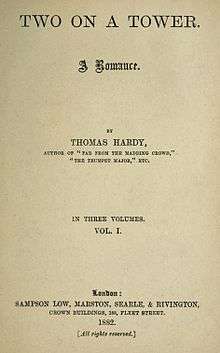Two on a Tower
 First edition title page | |
| Author | Thomas Hardy |
|---|---|
| Country | United Kingdom |
| Language | English |
| Genre | Novel |
Publication date | 1882 |
| Media type | |
Two on a Tower (1882) is a novel by English author Thomas Hardy,[1] classified by him as a romance and fantasy and now regarded as one of his minor works. The book is one of Hardy's Wessex novels, set in a parallel version of late Victorian Dorset.
Epigraph
Hardy placed an epigraph at the beginning of this book. The epigraph is from a Richard Crashaw poem, Love's Horoscope. It reads:
"Ah, my heart her eyes and she
Have taught thee new astrology.
Howe'er Love's native hours were set,
Whatever starry synod met,
'Tis in the mercy of her eye,
If poor Love shall live or die."
Plot
Two On A Tower is a tale of star-crossed love in which Hardy sets the emotional lives of his two lovers against the background of the stellar universe. The unhappily married Lady Constantine breaks all the rules of social decorum when she falls in love with Swithin St. Cleeve, an astronomer who is eight years her junior. Her husband's death leaves the lovers free to marry, but the discovery of a legacy forces them apart. This is Hardy's most complete treatment of the theme of love across the class and age divide and the fullest expression of his fascination with science and astronomy.
Background
In the 1895 preface Hardy wrote, "The scene of the action was suggested by two real spots in the part of the country specified, each of which has a column standing upon it. Certain surrounding peculiarities have been imported into the narrative from both sites." Wimborne was the location of the village of "Warborne", and Charborough House was the location of the "Welland House" in Two on a Tower.[2]
Hardy's intention, in his own words, was to "set the emotional history of two infinitesimal lives against the stupendous background of the stellar universe".[3]
Criticism
Because the book defied the social norms of the day, upon release the book was called shocking, repulsive, and one critic called it Hardy's "worst yet."[4] Hardy's biographer, Claire Tomalin, says Hardy was "writing for serialization, which drove him to pack in far too much plot," and he wrote too fast "without time to think or reconsider."[5]
Hardy wrote in a letter to Edmund Gosse on 10 Dec 1882, “I get most extraordinary criticisms of T. on a T. Eminent critics write & tell me in private that it is the most original thing I have done...while other eminent critics (I wonder if they are the same) print the most cutting rebukes you can conceive—show me (to my amazement) that I am quite an immoral person...”[6]
See also
References
- ↑ John Sutherland (1990) [1989]. "Two on a Tower". The Stanford Companion to Victorian Literature. p. 643.
- ↑ Letter from Hardy to Bertram Windle, transcribed by Birgit Plietzsch, from CL, vol 2, pp 131–133
- ↑ [From Hardy's 1895 preface to the book]
- ↑ Tomalin, Claire. "Thomas Hardy." New York: Penguin, 2007.
- ↑ Tomalin, Claire. "Thomas Hardy." New York: Penguin, 2007.
- ↑ Thomas Hardy's 'poetical matter' notebook
External links
- Two on a Tower full text at Google Books
- Two on a Tower at Project Gutenberg
-
 Two on a Tower public domain audiobook at LibriVox
Two on a Tower public domain audiobook at LibriVox